
Nudibranchs are a group of soft-bodied marine gastropod molluscs that shed their shells after their larval stage. They are noted for their often extraordinary colours and striking forms, and they have been given colourful nicknames to match, such as "clown", "marigold", "splendid", "dancer", "dragon", and "sea rabbit". Currently, about 3,000 valid species of nudibranchs are known.

Sea slug is a common name for some marine invertebrates with varying levels of resemblance to extraterrestrial slugs. Most creatures known as sea slugs are gastropods, i.e. they are sea snails that over evolutionary time have either completely lost their shells, or have seemingly lost their shells due to having a greatly reduced or internal shell. The name "sea slug" is most often applied to nudibranchs, as well as to a paraphyletic set of other marine gastropods without obvious shells.

Glaucus atlanticus is a species of small, blue sea slug, a pelagic (open-ocean) aeolid nudibranch, a shell-less gastropod mollusk in the family Glaucidae.

Chromodorididae, or chromodorids, are a taxonomic family of colourful, sea slugs; dorid nudibranchs, marine gastropod mollusks in the superfamily Doridoidea. “Chromodorid nudibranchs are among the most gorgeously coloured of all animals.” The over 360 described species are primarily found in tropical and subtropical waters, as members of coral reef communities, specifically associated with their sponge prey. The chromodorids are the most speciose family of opisthobranchs. They range in size from <10mm to over 30 cm, although most species are approximately 15–30 mm in size.
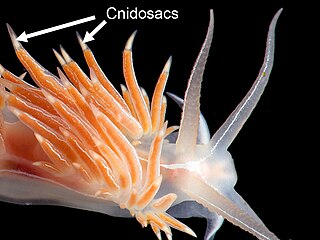
Cerata, singular ceras, are anatomical structures found externally in nudibranch sea slugs, especially in aeolid nudibranchs, marine opisthobranch gastropod mollusks in the clade Aeolidida. The word ceras comes from the Greek word "κέρας", meaning "horn", a reference to the shape of these structures.

A rhinophore is one of a pair of chemosensory club-shaped, rod-shaped or ear-like structures which are the most prominent part of the external head anatomy in sea slugs, marine gastropod opisthobranch mollusks such as the nudibranchs, sea hares (Aplysiomorpha), and sap-sucking sea slugs (Sacoglossa).
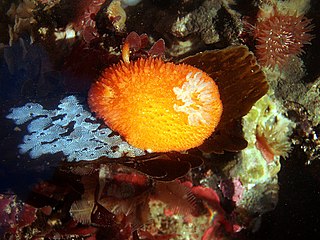
Acanthodoris lutea, the orange-peel doris, is a species of nudibranch or sea slug, a shell-less marine opisthobranch gastropod mollusk in the family Onchidorididae.

Peltodoris nobilis, commonly called the sea lemon, false sea lemon, or the noble dorid, is a species of colorful sea slug, a dorid nudibranch, a shell-less marine gastropod mollusk in the family Discodorididae.

Chromodoris willani, commonly known as Willan's chromodoris, is a species of sea slug, a dorid nudibranch, a shell-less marine gastropod mollusk in the family Chromodorididae. The species is named for the renowned nudibranch taxonomist Dr. Richard C. Willan.

Melibe viridis is a species of sea slug, a nudibranch, a marine gastropod mollusk in the family Tethydidae.
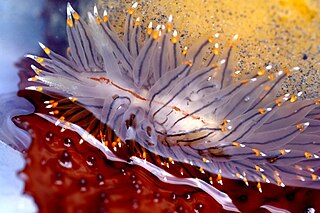
Janolus fuscus is a species of sea slug, or more accurately a nudibranch, a marine gastropod mollusk in the family Proctonotidae.

Nembrotha cristata is a species of colourful sea slug, a polycerid nudibranch, a marine gastropod mollusk in the family Polyceridae. This species of sea slug is black with green markings; adults are around 50 mm long, and they live on rock or coral reefs in the tropical Indo-West Pacific Ocean.
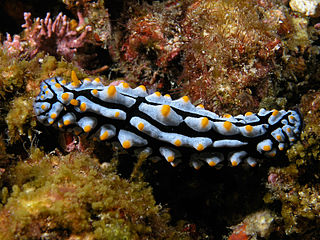
Phyllidia varicosa is a species of sea slug, a dorid nudibranch, a shell-less marine gastropod mollusc in the family Phyllidiidae.

Ceratosoma amoenum, or the clown nudibranch, is a species of colorful dorid nudibranch, a sea slug, a shell-less marine gastropod mollusk in the family Chromodorididae.
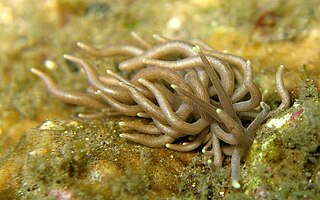
Phyllodesmium is a genus of predatory sea slugs, aeolid nudibranchs, marine gastropod molluscs in the family Facelinidae.

Tyrannodoris luteolineata is a species of sea slug, a polycerid nudibranch, a marine gastropod mollusc in the family Polyceridae.
Tyrannodoris tigris is a species of sea slug, a polycerid nudibranch, a marine gastropod mollusk in the family Polyceridae. It is a known predator of Tambje eliora and Tambje abdere, two species of smaller nudibranchs. The chemical extracts of all three species contain tambjamines, which were traced to Sessibugula translucens, a food source of these species. It is hypothesized that tambjamines are a chemical defence mechanism against feeding by the spotted kelpfish Gibbonsia elegans.

Diversidoris crocea is a species of colourful sea slug, a dorid nudibranch, a shell-less marine gastropod mollusk in the family Chromodorididae.

A cnidosac is an anatomical feature that is found in the group of sea slugs known as aeolid nudibranchs, a clade of marine opisthobranch gastropod molluscs. A cnidosac contains cnidocytes, stinging cells that are also known as cnidoblasts or nematocysts. These stinging cells are not made by the nudibranch, but by the species that it feeds upon. However, once the nudibranch is armed with these stinging cells, they are used in its own defense.

Melibe colemani, also known as the Coleman's melibe, ghost nudi, or ghost melibe, is a species of nudibranch in the family Tethydidae. Discovered by Neville Coleman in 2008 off the coast of the island of Mabul in Malaysia, it was formally described by Marta Pola and Terrence Gosliner in 2012 and named in honour of its discoverer. It is found throughout the Coral Triangle region of Malaysia, Indonesia, and the Philippines.
Kelaart, E.F., 1858. Description of a new Ceylonese nudibranch. Annals and Magazine of Natural History, series 3, 1(4): 257-258.

















